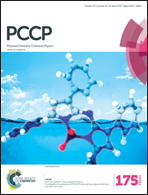Tuning the hydrogen evolution activity of MS2 (M = Mo or Nb) monolayers by strain engineering†
Abstract
Strain engineering is an effective strategy to tune the electronic, magnetic and optical properties of atomically thin materials like graphene and monolayer transition-metal dichalcogenides (m-TMDs). Using first-principles calculations, we show that strain is also effective for tuning the catalytic activity of m-MS2 (M = Mo or Nb) towards the hydrogen evolution reaction (HER), which is essential for electrochemical hydrogen generation from water splitting. A wide strain range covering both compressive (0–6%) and tensile (0–10%) regions is considered. It is found that biaxial tensile strain can enhance the HER activity more effectively than uniaxial tensile strain, while compressive strain deteriorates the HER activity. Compared with monolayer 1T-NbS2, monolayers 1T-MoS2 and 1H-NbS2 exhibit better strain tunability towards their HER activities since more active sites can be induced with increasing strain. In contrast, monolayer 1H-MoS2 is catalytically inert in the considered strain range because H adsorption is too weak. We demonstrate that tensile strain can lead to decrease of the adiabatic proton affinity but simultaneously a larger magnitude of increase of the adiabatic electron affinity, thus enhancing the catalytic activity. Electronic structure calculations show that tensile strain can activate the relatively inert inner valence electrons and enlarge the d-band exchange splitting, both of which induce destabilization of the system and enhancement of catalytic activity.


 Please wait while we load your content...
Please wait while we load your content...